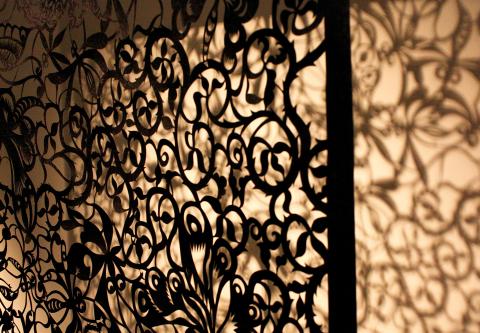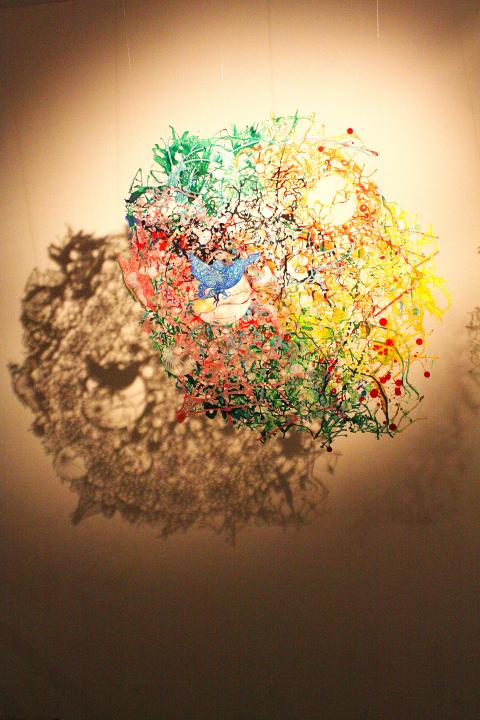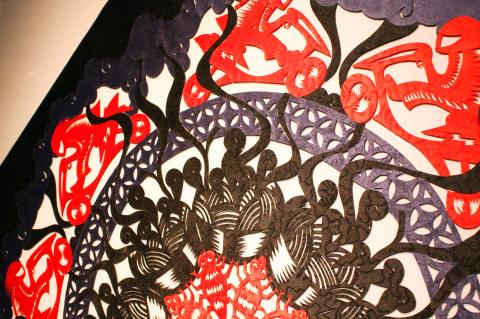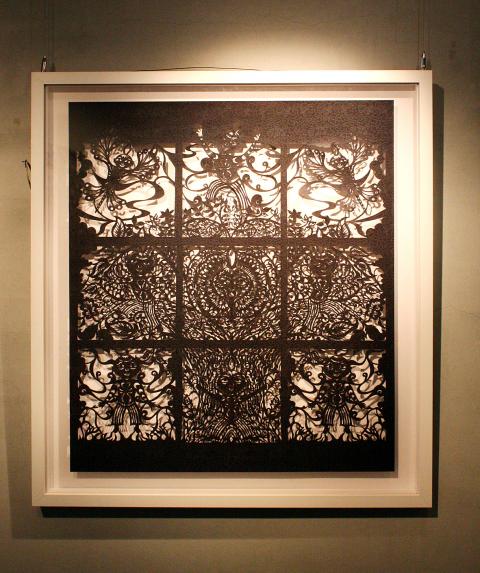Tim Budden’s papercuttings tell stories with shadows and light. The Wales-born artist’s spellbindingly intricate artwork is on display at the Suho Memorial Paper Museum (樹火紀念紙博物館) until March 24.
Before moving to Taiwan, Budden was a sculptor who created puppets and set pieces for theatrical performances. He also drew a critically acclaimed comic strip about a group of badgers living unhappily alongside humans.
After arriving in this country, Budden says he was uninterested in traditional Chinese art forms until he stumbled upon a book about papercuts created by retired women in China. He was struck by the similarity between the papercuts and the black-and-white line art he had used in his comic strips.

Photo courtesy of Suho Memorial Paper Museum
“They used papercuts to tell the story of their lives,” says Budden. “They were like cartoons, but 3D. You can touch them and hold them.”
Like his comic strip, many of Budden’s papercuts deal with the sometimes uneasy relationship between a place and its inhabitants. While his comics were about conflicts between badgers and the humans who threatened their safety, Budden’s papercut artwork offers a foreigner’s perspective on life in Taiwan. Many revolve around the adventures of a small child named Daniel, who is a composite of Budden and his young son.
“I’m not from Taiwan and I’m trying to understand this culture. I feel like a child, trying to understand more: ‘Why are they doing this, what is this for?’” says Budden.

Photo courtesy of Suho Memorial Paper Museum
Motifs seen in Budden’s complex, lacelike artwork include butterflies, steam wafting from hot bowls of beef noodle soup and cockroaches.
One work shows moped riders being swept away by torrents of water during a typhoon. Budden was struck by drivers who continue to speed recklessly even after roads have flooded and television news segments in which reporters put their safety at peril to venture into hazardous conditions and tell viewers the obvious (“It’s raining!”). Another papercut recounts the time Budden and his friend were forced to climb a tree to escape an angry wild boar after getting lost while hiking in Jinguashih (金瓜石).
Most of Budden’s papercuts are created from red or black paper backed with silk and have to be carefully planned in advance so the delicate designs will not tear or warp once they are completed and hung. One work, Butterfly Blast!, which features so many of the winged creatures that Budden has lost count, took six weeks to design and about 10 to 12 days to cut.

Photo courtesy of Suho Memorial Paper Museum
Budden is now experimenting with a more freeform technique inspired by colorful beach rocks and leaf skeletons he found during a trip to Hualian. He begins by spilling acrylic paint on paper and blowing on it through a straw so the colors run together.
“When it dries, you get these fantastic patterns,” says Budden. The random shapes and lines inspire the different shapes Budden cuts into the paper. On first glance, it is hard to discern what each individual detail is supposed to depict. When the papercuts are hung up and a light shone through them, however, the artwork casts strong, defined lines against the wall, allowing viewers to pick out butterflies and 24 different kinds of beetles.
“You can see one image when you look at papercutting and something completely different behind it,” says Budden. “Shadows for me are full of secrets.

Photo courtesy of Suho Memorial Paper Museum
ets.”

On April 26, The Lancet published a letter from two doctors at Taichung-based China Medical University Hospital (CMUH) warning that “Taiwan’s Health Care System is on the Brink of Collapse.” The authors said that “Years of policy inaction and mismanagement of resources have led to the National Health Insurance system operating under unsustainable conditions.” The pushback was immediate. Errors in the paper were quickly identified and publicized, to discredit the authors (the hospital apologized). CNA reported that CMUH said the letter described Taiwan in 2021 as having 62 nurses per 10,000 people, when the correct number was 78 nurses per 10,000

As we live longer, our risk of cognitive impairment is increasing. How can we delay the onset of symptoms? Do we have to give up every indulgence or can small changes make a difference? We asked neurologists for tips on how to keep our brains healthy for life. TAKE CARE OF YOUR HEALTH “All of the sensible things that apply to bodily health apply to brain health,” says Suzanne O’Sullivan, a consultant in neurology at the National Hospital for Neurology and Neurosurgery in London, and the author of The Age of Diagnosis. “When you’re 20, you can get away with absolute

May 5 to May 11 What started out as friction between Taiwanese students at Taichung First High School and a Japanese head cook escalated dramatically over the first two weeks of May 1927. It began on April 30 when the cook’s wife knew that lotus starch used in that night’s dinner had rat feces in it, but failed to inform staff until the meal was already prepared. The students believed that her silence was intentional, and filed a complaint. The school’s Japanese administrators sided with the cook’s family, dismissing the students as troublemakers and clamping down on their freedoms — with

As Donald Trump’s executive order in March led to the shuttering of Voice of America (VOA) — the global broadcaster whose roots date back to the fight against Nazi propaganda — he quickly attracted support from figures not used to aligning themselves with any US administration. Trump had ordered the US Agency for Global Media, the federal agency that funds VOA and other groups promoting independent journalism overseas, to be “eliminated to the maximum extent consistent with applicable law.” The decision suddenly halted programming in 49 languages to more than 425 million people. In Moscow, Margarita Simonyan, the hardline editor-in-chief of the